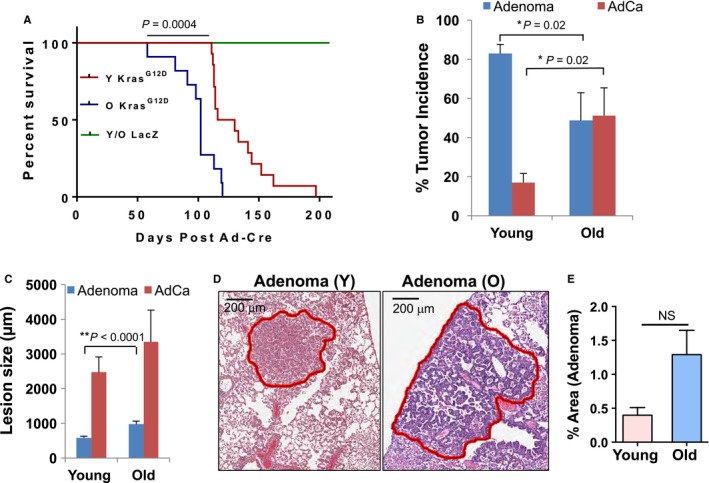Figure 2.

Old mice show shorter survival and more aggressive tumors at the end stage of tumor analyses. (A) Old Kras G12D mice (19–20 months, n = 11) have lower cumulative survival than young Kras G12D mice (3–5 months, n = 14) as measured by log‐rank survival analysis. (B) The incidence of lung adenoma and adenocarcinoma in young (3–5 months, n = 8) and old Kras G12D mice (19–20 months, n = 7) was assessed histologically on H&E‐stained median lung sections from each mouse. Based on histological analysis, the incidence for adenoma and adenocarcinoma (AdCa) was calculated as the percentage of adenoma or adenocarcinoma of total number of lung tumors observed per lung section and per mouse (n = 52 lung tumors in young and n = 37 lung tumors in old mice). (C) The size of tumors was analyzed and compared between young and old Kras G12D mice by measuring the largest diameter of each lung tumor/lesion using Aperio ImageScope software. Data from 44 adenoma lesions and nine adenocarcinomas from eight young mice, 26 adenoma lesions and 11 adenocarcinoma lesions from 7 old mice are plotted. (D) Representative digital images of scanned H&E lung sections used for morphometric analysis of adenoma from young (Y) and old (O) Kras G12D mice. (E) Percent tumor area (including adenoma and adenocarcinoma) with respect to total lung surface area was obtained using Aperio ImageScope software and is presented in the plotted diagram for old and young Kras G12D mice in the tumor latency study.
